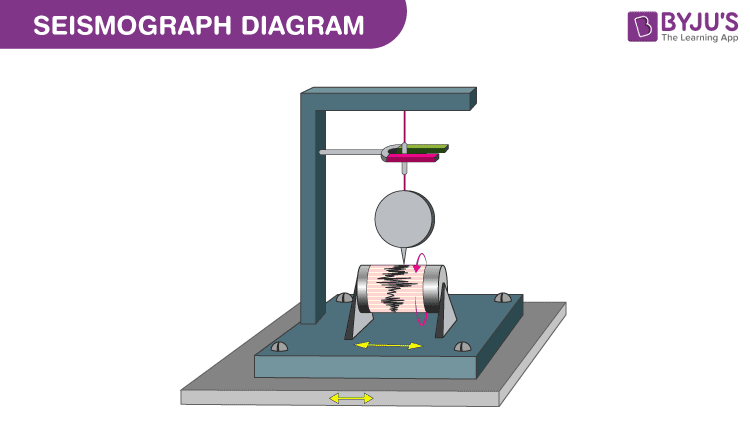Natural disasters are catastrophic events that cause fatalities, property damage and environmental disruption. Earthquake is one of the significant natural disasters, and every year it causes a massive loss of life and property worldwide. An earthquake is an event where the Earth’s surface shakes due to the sudden release of energy in the Earth’s crust. As a result, seismic waves (also known as S waves) are generated. The seismic activities in an area determine the earthquake’s type and intensity. Scientists measure and record the seismic activities that occur during an earthquake with the help of an instrument known as the Seismograph. In this article, let us familiarise ourselves with Seismograph.
|
Table of Contents |
What is a Seismograph?
A seismograph is an instrument that measures and documents vital information about earthquakes. Seismographs are equipped with electromagnetic sensors that translate ground motions into electrical voltages.
A seismograph aids scientists in detecting earthquakes and measuring several aspects of the event, such as:
- The time at which the earthquake occurred.
- The epicentre is the location on the surface of the Earth below which the earthquake occurred.
- The depth below the Earth’s surface at which the earthquake occurred.
- The amount of energy released by the quake.
Seismograph Definition
A seismograph is an instrument that measures and registers seismic waves that travel through the Earth as the outcome of an earthquake.
The terms seismograph and seismometer are often used correspondingly; however, unlike the Seismograph, seismometer doesn’t possess the capacity to record the phenomena. A record produced by a seismograph on a display screen is known as a seismogram.
How does a Seismograph Work?
The working principle of Seismograph is relatively simple.
A basic Seismograph consists of a solid base and a heavyweight suspended from a spring over the base. A pen hangs from the weight, and a rotating drum with paper sits below it on the base. The tip of the pen touches the drum. When the earth shakes from an earthquake, the drum rotates, and the weighted pen moves back and forth due to the motion of seismic waves. The pen records the movement on the drum. The paper recording of an earthquake is called a seismogram.
A seismograph is securely mounted onto the surface of the earth. Except for the mass on the spring, the entire unit shakes when the earth shakes. The heavyweight mass remains in the same place due to its inertia. The recording device on the mass records the relative motion between itself and the rest of the instrument as the seismograph shakes under the mass, thus recording the ground motion. In reality, these mechanisms are no longer manual but instead work by measuring electronic changes produced by the ground’s motion with respect to the mass.
The most high-tech seismographs used by scientists studying earthquakes today are sophisticated and precise. They are based on the same concept as a basic, simple seismograph but use electronics, magnets, and amplifiers to accurately and precisely measure the tiniest ripples in the earth caused by earthquakes.
Seismograph Diagram

An earthquake is a sudden shaking of the earth, which results in the movement of the Lithospheric plates. Watch the video and visualise how earthquakes are caused!

How are Earthquakes Located?
An earthquake generates different seismic waves that travel through Earth at different speeds. P-waves travel the fastest, followed by the slower S-waves. The arrival times of the P- and S-waves at different seismometers are used to determine the earthquake’s location. The time difference between the P- and S-waves arrivals determines the distance the earthquake is from the seismometer. By looking at the seismograms from different recording stations, we can determine the earthquake’s epicentre. The signals arrive first at the closest station and last at the furthest away. The time difference between the P- and S-waves tells us the earthquake’s distance from the seismometer. If we calculate the S minus P time to determine the distance from the seismometer at three stations, we can determine where the earthquake’s epicentre is.

Once we understand the distance to an earthquake from three seismic stations, we can determine the earthquake’s location. A, B and C are three different seismometer stations located at distant locations. Draw a circle around each station with a radius equal to its distance from the earthquake. The earthquake occurred at the point where all three circles intersect.
|
Related Reading |
|---|
Seismograph Example
The below image shows an example of a seismograph. The wiggly lines in the image are the seismic waves that the seismograph has recorded.

Most of these waves are so small that they are negligible. Most of these microseisms are mainly caused due to nearby activities, such as heavy traffic or wind, or by distant sources such as interactions of waves with the ocean floor.
The P wave of the earthquake will be the first wiggle that is bigger than the background wiggle because they are the first earthquake waves that a seismograph records. The next set of seismic waves on your seismogram will be the S waves, and they are usually more significant than the P waves.
Frequently Asked Questions – FAQs
Why is a Seismograph important?
Seismographs are vital because they help scientists detect earthquakes and measure several aspects of the event.
When was Seismograph technology invented?
The first seismograph was developed in 1890.
How does a Seismograph record earthquake data?
As the seismograph shakes under the mass, the recording device on the mass records the relative motion between itself and the rest of the instrument, thus recording the ground motion.
Where is a Seismograph located?
Seismographs are held in a very solid position, either on the bedrock or on a concrete base.
Can Seismograph locate epicentre?
When seismic data is collected from at least three different locations, it can determine the epicentre by where it intersects.
Stay tuned to BYJU’S and Fall in Love with Learning!

Comments